Once Upon a Time…
Or, rather, approximately 1-2 million years ago, the ancestors of modern bonobos and chimpanzees were a single species that lived in the rainforests of the Congo. This ancestral group is thought to have inhabited the areas north of the Congo River, barred from moving south by the wide and treacherous river itself, known to be the deepest river in the world.
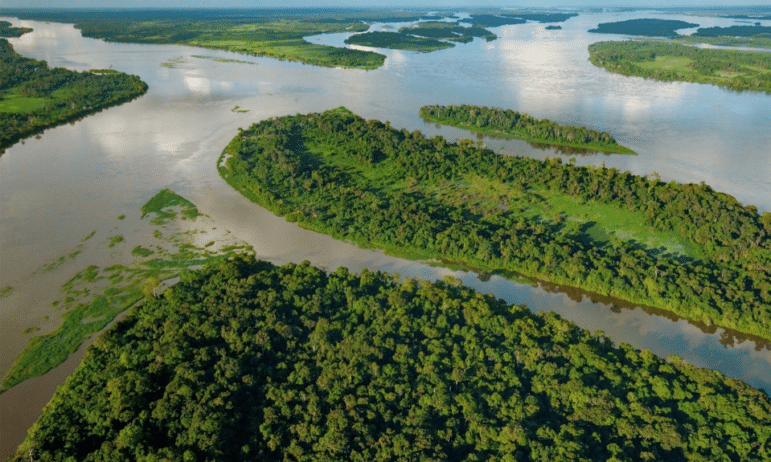
Around that same time, sediment analyses show the flow of the river dropped significantly. The waters of the Congo receded from the banks on either side for a short moment in geological time, making the river shallower and less formidable.
It might have been shallow enough to inspire a bold and curious group of ancestral apes to attempt a crossing.
Shortly after the hypothesized river crossing of bonobo ancestors, the banks of the Congo once again flooded with water, separating the intrepid group of apes from their relatives north of the river forever after.
North of the river, competition for resources made life hard. The ancestors of chimpanzees had to compete with other troops of their own kind as well as ancestral gorillas for both food and territory. As a result, they evolved a tougher disposition so as to be able to defend themselves when thieves and invaders threatened their land and their group members.
Fighting for Survival
Because violence and fighting skills improved their chances at survival, chimpanzees were evolutionarily selected for aggressive tendencies. In plain terms, this means the tough chimps survived long enough to reproduce and pass on their tough-guy traits to their offspring. Today, members of modern chimpanzee species have been observed attacking group members, raping females, killing infants, and murdering other adult chimpanzees.
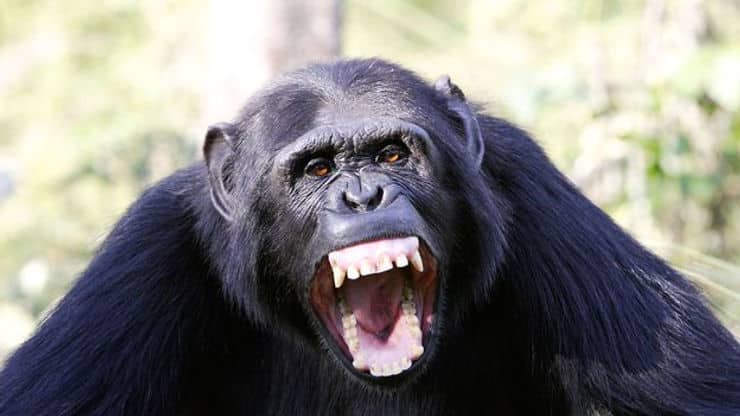
Tra la la – Life is Good
By comparison, south of the river, the migrant apes had it good. There were no ancestral gorillas, and few other species to compete with. Food was plentiful, and uninhabited territory stretched on and on.
Because of this, these apes had no particular use for aggression. They began to share. Instead of violence being a key skill for survival, over time friendship and cooperation became the most coveted traits.
Females with the most friends had the best chances of survival, because they could band together to ensure that the bigger males couldn’t bully them. By leaning on their expanded social networks, females began to have the upper hand. Eventually they became the dominant sex.
By leaning on their expanded social networks, females began to have the upper hand.
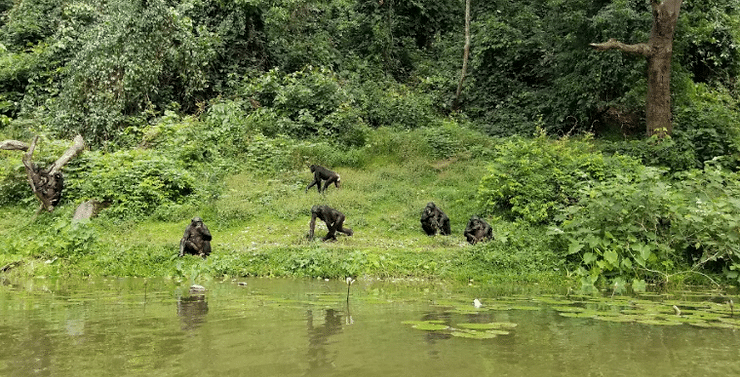
With plenty of food and no reason for conflict, the migrant apes thrived in their new territory. Over time, their body shape became more slender and less stocky than their chimp cousins’. They learned to cooperate with each other and to be tolerant of strangers. And, amazingly, their neurobiology — the form and functions of their brains and their chemical make-up — began to change as well.
Today, when faced with social conflicts, chimpanzees begin to produce extra testosterone, causing their hackles to raise and their bodies to tense. This chemical triggers an aggressive response that releases tension and restores testosterone levels to equilibrium.
Why Bonobos are Called the “Make Love, Not War” Ape
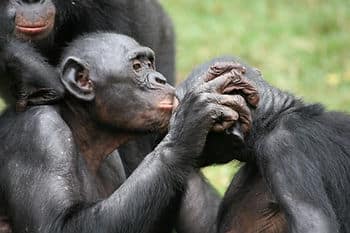
Bonobos respond to conflict in a completely different way. When faced with moments of social tension, bonobos produce not testosterone, but cortisol, the body’s primary stress hormone. They don’t become aggressive, but anxious.
To relieve their discomfort, they resort to sociosexual behavior. Instead of attacking, they hug and kiss group mates, or engage in brief sexual encounters. These encounters occur across all ages and genders.
Bonobos: Only in the DR Congo
Bonobos today are still only found in a tiny part of the world, south of the Congo River in the Democratic Republic of Congo. They still don’t encounter chimpanzee or gorilla competitors, but now they have a far more dangerous ape adversary: humans.
Bonobos are under constant threat from human poaching and deforestation, which is shrinking their rainforest home further and further with each passing year.
Today, bonobos have a far more dangerous ape adversary: humans.
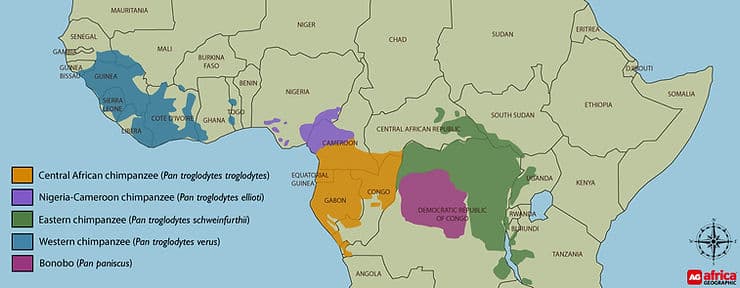
In the DR Congo, chimpanzees are still found north of the Congo River, neither species seeming to want to attempt another crossing. Chimpanzees tend to avoid the water entirely, while bonobos will wade in about waist deep for foraging purposes, but refuse to go further than that. Neither chimpanzees nor bonobos appear able to swim, and the species remain separate.
What does this story tell us? Extra food can change history, and a little tolerance can mean the difference between a peaceful society and a violent one. So next time you encounter an adversary, channel your ancestral bonobo, not your inner chimp.
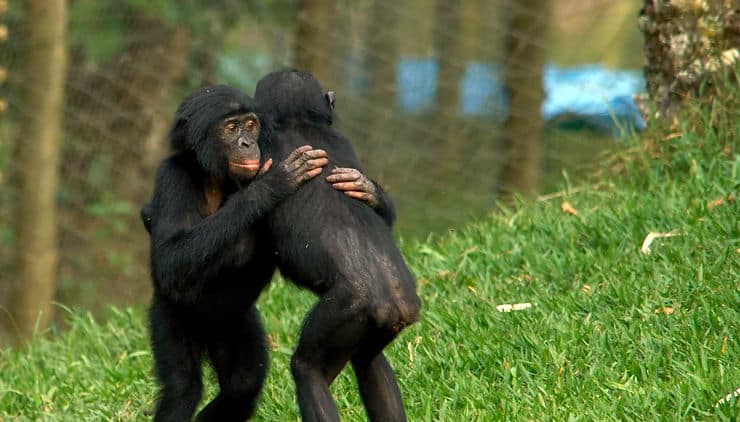

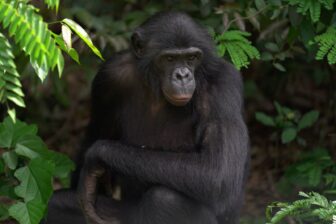 Kendra is a creative problem-solver who provides executive and operational support across the organization. As Executive Assistant to Ariel Rogers, she manages scheduling, communications, and day-to-day priorities while also supporting the development and communications teams with administrative and operational needs.
Kendra is a creative problem-solver who provides executive and operational support across the organization. As Executive Assistant to Ariel Rogers, she manages scheduling, communications, and day-to-day priorities while also supporting the development and communications teams with administrative and operational needs. Kathleen Cook brings more than nine years of experience working across Africa, with a focus on the Democratic Republic of Congo, where she has traveled over twenty times to support projects spanning conservation, clean energy, and community development. Her career has centered around using storytelling, strategic marketing, and relationship-building to create meaningful impact.
Kathleen Cook brings more than nine years of experience working across Africa, with a focus on the Democratic Republic of Congo, where she has traveled over twenty times to support projects spanning conservation, clean energy, and community development. Her career has centered around using storytelling, strategic marketing, and relationship-building to create meaningful impact.
